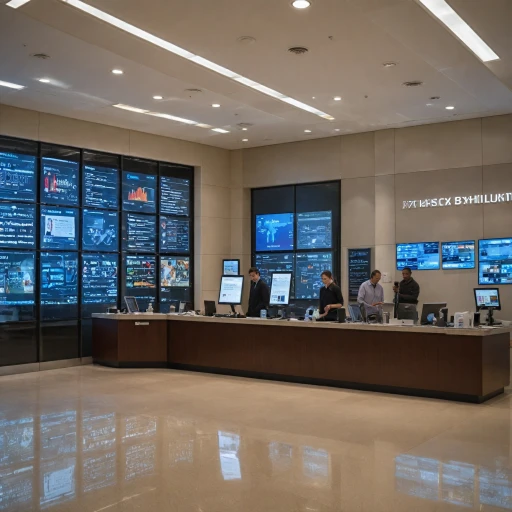Understanding Customer Experience: What Does CX Mean?
Cracking CX: The Key to Delightful Customer Interactions
Understanding the Basics of CX
Customer experience, or CX, is not just another buzzword in the business lexicon; it's a strategic pillar that can make or break a company's success. CX refers to how customers perceive their interactions with your brand throughout their entire journey, from awareness to post-purchase support. Nurturing positive customer experiences can lead to greater loyalty and increased revenue.
Why Customer Experience Matters
In today's competitive market, customers have higher expectations than ever. According to Gartner, 81% of companies primarily compete based on customer experience. Getting CX right isn't just a nice-to-have; it's crucial for differentiation. When CX works, 73% of consumers say they remain loyal to a brand. Conversely, a single bad experience drives 32% of customers away.
What Customer Experience Encompasses
Customer experience includes every touchpoint a customer has with your brand. From marketing, sales, and service interactions to product usability and customer service, it's all part of the CX equation. Effective customer experience management (CXM) can lead to ongoing improvements across these areas.
Customer Experience Versus Customer Service
It's tempting to conflate CX with customer service, but the two are different. While customer service is reactive—offering support when issues arise—CX is proactive. It's about shaping the entire customer journey to make each interaction as seamless and enjoyable as possible. This proactive approach helps in building a positive brand perception over time.
The Importance of Customer Feedback
Understanding what does customer feedback mean to your CX strategy can't be overstated. Real-time feedback systems like surveys and social media listening tools help in capturing customer sentiments as they occur. According to Temkin Group, companies with a high-quality CX outperform their competitors by 15% in customer satisfaction. In essence, feedback forms the backbone of a strong customer experience strategy.
Customer Journey Management
The journey a customer takes with your brand is as important as the destination. Using tools like customer journey mapping can paint a clear picture of all interactions and experiences customers have along their path. This helps businesses identify pain points and opportunities for improving customer experiences. Check this comprehensive guide for further insights on customer journey analytics.
Leveraging Data for CX Improvements
Data is king when it comes to refining customer experience. Utilizing behavioral analytics, preference data, and personalized marketing strategies can result in more tailored experiences that resonate with individual customers. A report by Oracle shows that data-driven CX improvements can increase customer lifetime value by up to 40%.
Case Studies: Success Stories in CX
Brands like Amazon and Netflix have set the gold standard for exceptional CX. Amazon's commitment to customer-centricity has earned it the top spot in customer satisfaction surveys for years, while Netflix's personalized recommendations keep users hooked. These companies demonstrate that investing in CX is not just profitable—it's essential for long-term success.
The Customer Journey: Mapping Your Way to Success
Defining the Customer Journey
To truly understand what does CX mean in today's context, let's start with a straightforward question: how do customers interact with your brand? The customer journey is the complete experience a customer has with your company, from the very first point of contact to post-purchase interactions. It's crucial, whether they're browsing your website, calling customer service, or clicking through an email campaign.
Mapping Milestones in the Customer Journey
Every successful business needs to meticulously track each customer touchpoint. According to Gartner, 67% of customer loyalty is driven by the quality of experiences during the entire journey. Mapping this journey involves pinpointing key moments, such as awareness, consideration, purchase, and post-purchase, to improve your offerings and enhance customer satisfaction.
Real-World Example to Illuminate Journey Mapping
Take Amazon, for instance. They have perfected the customer experience by excelling at every stage of the customer journey. From a seamless online shopping experience to timely deliveries and reliable customer service, they've set a benchmark for others. Understanding these stages allows companies to tailor services for better experience customer interactions.
Insights from Experts
According to customer service guru Shep Hyken, “Companies should view customer service as a journey, not a destination. Continuous improvement is a must.” Hyken's insights emphasize that a customer's journey doesn't end with a sale. By continuously mapping and evolving this journey, businesses can achieve a customer-centric approach.
Customer Journey Mapping Techniques
Successful brands employ various techniques to map this journey effectively. Oracle suggests using data analytics to track metrics like customer effort score and net promoter score (NPS) to identify pain points and areas for improvement. This data-driven approach helps companies focus on what truly matters to their customers.
Metrics to Measure
Tracking metrics like NPS and customer satisfaction scores can provide actionable insights into where the journey can be improved. A study from Microsoft found that companies that leverage such feedback effectively see up to a 20% increase in customer satisfaction. These metrics play a crucial role in shaping strategies for better customer experiences.
Understanding Friction Points
Identifying and mitigating friction points in the customer journey is equally important. Friction points are areas where customers experience difficulties, leading to dissatisfaction. Companies like Netflix continually analyze user data to ensure a smooth and user-friendly experience, reducing churn and boosting customer loyalty.
The Gains
By mapping and refining the customer journey, businesses not only enhance customer satisfaction but also build a more robust and loyal customer base. Companies that do this well are often rewarded with higher net promoter scores and customer loyalty, indicating stronger trust and repeat business.
Case Study: Oracle's Customer-Centric Approach
Oracle has successfully adopted a customer-centric approach through their Oracle Customer Experience (CX) Cloud suite. This suite empowers businesses with tools to streamline every interaction, ensuring a good customer experience. It offers personalized services that adapt to the varied needs of customer interactions, blending marketing, sales, service, and social activities seamlessly.
Conclusion: The Path Forward
Understanding and mapping the customer journey is a cornerstone of providing exemplary customer experience. It's not just about making the sale but about nurturing a long-term relationship. For a comprehensive grasp of a holistic approach to customer satisfaction, check out the role of a modern business strategy in enhancing customer experiences at Chief Customer Officer Insights. Stay tuned for the killer segue into how gathering and analyzing customer feedback can make or break your CX strategy.
Customer Feedback: The Backbone of Great CX
Why Customer Feedback Matters More Than Ever
Customer feedback is the backbone of great CX, let’s be real. It's what guides businesses to understand what they’re doing right and, more importantly, where they’re falling short. According to Gartner, by 2024, organizations that leverage customer feedback analytics effectively will see a 25% increase in customer retention rates. Feedback helps brands innovate, discover new trends, and understand customer pain points. It's not just about asking, 'How did we do?' anymore—it's about diving deep into that response and using it to shape your entire operation.
Collecting Feedback: The Modern Approach
Gone are the days when feedback meant handing out a piece of paper and asking for thoughts. Nowadays, advanced tools—think SurveyMonkey, Qualtrics, and even social media platforms—help businesses gather, analyze, and act on customer feedback in real-time. A report by Oracle shows that 77% of customers view brands more favorably if they proactively invite and act on feedback. Additionally, companies like Netflix use customer data constantly to refine their user experience, ensuring they stay ahead of the curve.
Feedback Loops: Closing the Circle
The concept of feedback loops is where the magic happens. This isn't just about collecting data; it's about creating a systematic process to act on this data continuously. Companies need to establish a closed-loop feedback system where customer insights directly influence business decisions. A study by McKinsey emphasized that businesses with strong feedback loops see up to 15% higher revenue growth rates. This means creating a structure where customer replies are integrated rapidly into product development, service improvements, and overall strategy.
Turning Feedback into Actionable Insights
It’s not just about gathering insights but also about translating them into actionable strategies. Amazon is a quintessential example here. They actively seek customer feedback and use it to drive everything from website tweaks to their wide array of products and services. Jeff Bezos famously has a seat at every meeting for 'the customer,' ensuring that customer feedback informs every decision the company makes. This focus on customer-centricity has allowed Amazon to build unprecedented loyalty and achieve a high Net Promoter Score (NPS).
Real-Life Cases: Businesses Nailing Customer Feedback
Take Netflix again. They noticed a significant portion of their users frequently paused videos. Digging deeper into their feedback, they realized it was due to the absence of a 'skip intro' button. They implemented this feature, which drastically improved user experience and customer satisfaction. Similarly, Nasa receives constant feedback from their stakeholders and team, enabling them to make technology and process improvements continuously.
Want to learn more about transforming business strategy through customer insights? Check out The Power of Feedback Loops: Transforming Business Strategy with Customer Insights.
Net Promoter Score (NPS): Measuring Customer Loyalty
Understanding Net Promoter Score (NPS) for Customer Loyalty
Customer experience (CX) isn't just a buzzword; it's the lifeblood of modern businesses. Among the many metrics used to gauge this, the Net Promoter Score (NPS) stands out as a solid indicator of customer loyalty. But what does NPS mean exactly?
What is NPS and Why Does It Matter?
Simply put, NPS measures the willingness of customers to recommend a company's products or services to others. It's a direct reflection of customer satisfaction and loyalty, which are key components of a great customer experience. According to a study by Bain & Company, businesses with higher NPS grow at more than twice the rate of their competitors.
Calculating NPS: The How-To
NPS is calculated based on a single question: “On a scale of 0 to 10, how likely are you to recommend our product/service to a friend or family member?” Respondents are categorized as:
- Promoters (9-10): Loyal enthusiasts who will keep buying and refer others, driving growth.
- Passives (7-8): Satisfied but unenthusiastic customers who are vulnerable to competitive offerings.
- Detractors (0-6): Unhappy customers who can damage your brand and impede growth through negative word-of-mouth.
NPS is then calculated by subtracting the percentage of Detractors from the percentage of Promoters. The score can range from -100 (if every customer is a Detractor) to 100 (if every customer is a Promoter).
The Power of NPS in Business Strategy
Why is this metric so powerful? Well, customer-centric companies like Amazon and Netflix leverage NPS as a core component of their strategic framework. Amazon's obsession with customer feedback and continuous improvement has earned it an NPS of 62, significantly higher than the retail industry average of 24. Similarly, Netflix boasts an NPS of 68, showcasing the power of customer loyalty in driving subscription and long-term growth.
Expert Insights on NPS
Fred Reichheld, a Bain Fellow and creator of the NPS system, states, “NPS is about more than just measurement; it’s about optimizing customer experiences.” Reichheld emphasizes that understanding the root causes of customer feedback can transform businesses, not just by retaining customers but by converting them into passionate promoters.
Common Missteps and Controversies
Despite its popularity, NPS isn't without its controversies. Some experts argue that it oversimplifies customer sentiment. For instance, a report by Gartner suggests that while NPS is a useful metric, it should be combined with other indicators like Customer Effort Score (CES) and Customer Satisfaction (CSAT) for a more holistic view.
Case Study: The NPS Difference at Apple
Apple has consistently used NPS to refine its customer experience strategy. By closely monitoring NPS feedback, Apple discovered key areas where they could enhance the user experience. This data-driven approach helped boost its NPS score to an impressive 72, contributing to its status as a leader in consumer electronics.
Practical Tips for Implementing NPS
Ready to leverage NPS to improve your customer experience? Here are a few actionable steps:
- Regularly survey your customers and categorize the feedback.
- Act on the insights – improve areas that detractors mention.
- Follow up with promoters to encourage referrals and deeper engagement.
- Combine NPS with other customer feedback metrics for a balanced view.
By effectively utilizing NPS, businesses can not only gauge customer loyalty but also drive meaningful improvements in their customer experience strategies, leading to sustained business growth.
The Role of Technology in Enhancing Customer Experience
Technology's Impact on Customer Experience
Technology has dramatically reshaped how businesses engage with their customers. In an era where digital interactions dominate, companies must leverage technology to enhance the customer experience (CX), making it seamless and personalized.
Omnichannel Presence
One of the critical advancements in CX is the establishment of an omnichannel presence. Customers expect to interact with brands through various channels—whether it's social media, email, chatbots, or physical stores. According to an insight by Gartner, organizations with omnichannel strategies retain 89% of their customers, compared to 33% for companies with weak omnichannel strategies.
Personalization Through Data
Personalization is another pivotal area where technology plays a significant role. By analyzing customer data, businesses can tailor experiences to individual preferences. A report by Oracle found that 75% of consumers prefer brands that use personal information to create more relevant experiences. This can range from personalized emails and product recommendations to targeted ads.
AI and Machine Learning
Artificial Intelligence (AI) and Machine Learning (ML) are reshaping customer service. AI-driven chatbots can handle a multitude of queries simultaneously, offering quick resolutions and freeing human agents to tackle complex issues. A study by Salesforce reveals that AI adoption in customer service has grown by 270% over the past four years. This technology helps in providing 24/7 customer support and improving efficiency.
Feedback Systems and Analytics
Efficient feedback systems are also essential for a great CX. Collecting and analyzing customer feedback through various automated platforms helps businesses to quickly understand and act on areas needing improvement. Qualtrics research shows that companies that systematically collect and analyze feedback outperform their competitors by 10% in terms of customer satisfaction.
Case Study: Netflix
Netflix is a prime example of leveraging technology to enhance CX. Using data analytics and algorithms, Netflix provides personalized content recommendations, resulting in binge-worthy sessions that keep users tied to their screens. Their customer-centric technology approach has played a significant role in maintaining a 93% customer retention rate, according to a Statista report.
Future Trends
The future of CX technology looks promising. Trends point towards greater use of AI, more sophisticated data analytics, and enhanced virtual and augmented reality experiences. Companies that stay ahead in these technological advancements will likely lead in customer satisfaction and loyalty.
Integrating technology to bolster CX is not just beneficial but necessary for modern businesses competing in the digital age. Implementing these advances can lead to a more streamlined, efficient, and satisfying customer journey.
Building a Customer-Centric Culture
Embedding a Customer-Centric Mindset
Creating a customer-centric culture goes beyond posting motivational quotes in the company break room. It starts with embedding a genuine desire to prioritize the customer into the DNA of your company. According to Gartner, 81% of executives believe that the integration of customer-centric values is critical for profit growth. This means top-down commitment—leaders need to lead by example. Personalized customer interaction isn't just for the customer service team; every department, from marketing to R&D, benefits from stepping into the customer's shoes.
Training and Empowerment: The Backbone
Training employees to understand and prioritize customer experience management (CXM) is a game-changer. According to a Oracle report, companies that foster a proactive support environment experience 26% higher customer satisfaction. Equip your employees with the tools and autonomy they need to respond promptly to customer inquiries. Train them to use technology efficiently, making user experience seamless on all fronts—from replying to emails to providing solutions on social media platforms.
Feedback Loops: Making Conversations Count
Establishing effective feedback loops is essential for sustaining a customer-centric culture. Use customer feedback as a compass for refining and improving your service offerings. Net Promoter Score (NPS) or Customer Effort Score (CES) surveys can be instrumental in assessing and enhancing customer loyalty. As reported by Nordic APIs, companies using NPS saw a 33% increase in mention-positive responses (MPS—yes, this is an industry term!). Haven’t started on your feedback loop strategy yet? Get cracking—your customers will thank you.
Recognizing Effort: Rewarding Customer-Focused Performance
Nothing fosters a customer-centric culture better than employee recognition and rewards. Having an internal awards system for employees who excel in customer service can make a huge impact. According to Forbes, companies with solid employee recognition programs enjoy a 31% lower turnover rate. This is significant, as happy employees often cultivate happy customers.
Case Study: Amazon's Obsession with Customer Experience
Let's talk Amazon for a second. Founder Jeff Bezos has always put an obsessive focus on customer satisfaction. Every year, Bezos includes an empty chair at his executive meetings to represent 'the customer,' reminding everyone that the customer is a key part of every decision. Known for its phenomenal customer service and seamless user experience, Amazon sets the gold standard. The company's commitment to its customers has paid off big-time. According to Statista, Amazon's net revenue reached $469.8 billion in 2021.
Start Small, Think Big
Building a customer-centric culture doesn't happen overnight. Start by integrating minor adjustments, like thanking customers for their feedback or ensuring that complaints are addressed promptly. Over time, these small actions collectively cultivate a sustainable customer-centric environment. Remember, the journey to great customer experiences (CX) begins with little steps but leads to monumental growth.
Key Metrics to Track for Improved Customer Experience
Customer Satisfaction Score (CSAT)
Understanding what customer experience means involves tracking various metrics, and the Customer Satisfaction Score (CSAT) is one of the most direct indicators. This metric measures how satisfied customers are with a specific interaction, service, or product. According to a survey by Gartner, companies that actively monitor CSAT scores see a significant increase in customer loyalty. It's calculated by asking customers to rate their satisfaction on a scale, usually from 1 to 5.
For instance, Amazon's use of CSAT scores in their customer service centers has been illustrative. Their focus on speedy resolution and courteous service has resulted in high satisfaction rates. Amazon reports an average CSAT score of 84%, showcasing the importance of meeting customer expectations promptly.
Net Promoter Score (NPS)
The Net Promoter Score (NPS) is crucial for understanding customer loyalty. Developed by Fred Reichheld, NPS asks one simple question: "On a scale of 0-10, how likely are you to recommend our company to a friend or family member?" This score divides respondents into Promoters (9-10), Passives (7-8), and Detractors (0-6).
For example, Netflix uses NPS to gauge customer satisfaction and loyalty. According to a study by the Harvard Business Review, Netflix boasts an NPS of 77, highlighting their ability to provide valuable customer experiences consistently. They use this data to tailor their offerings and maintain high levels of customer engagement.
Customer Effort Score (CES)
The Customer Effort Score (CES) focuses on the ease of customer interactions. This metric asks customers to rate how much effort they had to put in to get their issue resolved. Research by the Gartner Group found that 96% of customers with a high-effort experience will become more disloyal over time, whereas only 9% of those with low-effort experiences will do the same.
Take Oracle's approach: they simplified their online support system, resulting in a CES improvement of 15%. This enhancement directly affected their customer retention rates.
Customer Lifetime Value (CLV)
Customer Lifetime Value (CLV) indicates the total revenue a business can expect from a single customer account. By enhancing CLV, businesses can better allocate marketing and sales resources. A study by ISO reveals that businesses focusing on increasing CLV see a 25% boost in revenue.
For instance, healthcare companies like Kaiser Permanente focus on personalized care and follow-ups to increase patient CLV. This strategy not only improves patient satisfaction but also encourages long-term loyalty.
Customer Retention Rate (CRR)
The Customer Retention Rate (CRR) illustrates the percentage of customers a company retains over a specific period. A higher retention rate often correlates with high satisfaction and loyalty. According to research by NASA, improving customer retention by just 5% can increase profitability by 25-95%.
Case in point: Sephora's Beauty Insider program rewards repeat purchases, resulting in a remarkable CRR of 80%. This loyalty program is a prime example of how understanding and rewarding customer behaviors can drive long-term success.
Customer Churn Rate
The Customer Churn Rate measures how many customers leave a company over a given timeframe. A high churn rate indicates dissatisfaction and can guide improvement strategies. According to Gartner's analysis, companies with optimized customer experience practices see their churn rates reduced by 10-15%.
For example, Spotify identified high churn rates and introduced personalized playlists and improved user interfaces, resulting in a 20% reduction in churn. These changes highlight the significance of adapting to customer needs.
Case Studies: Companies Excelling in Customer Experience
Transforming Experiences: Lessons from Leading Brands
When we talk about customer experience (CX), certain giants like Amazon, Netflix, and Apple come to mind. These brands don’t just sell products—they create memorable experiences. Amazon, for example, revolutionized the online shopping experience with its customer-centric approach. In a 2022 survey, 89% of Amazon shoppers highlighted the ease of use of its platform as a major advantage. Their focus on speedy delivery, personalized recommendations, and superior customer service sets an industry benchmark.
Harnessing Technology for Superior CX
Netflix stands out for its use of advanced algorithms and big data to recommend content tailored to user preferences. This personalized touch keeps 77% of users binge-watching more shows, enhancing user engagement and customer loyalty. Their ability to harness technology to offer a personalized user experience is a lesson in how tech can elevate CX.
Innovative Approaches: Oracle in Customer Experience
Oracle’s focus on experience management is another example. They’ve implemented advanced customer relationship management (CRM) systems to monitor and enhance customer interactions. According to Gartner, using CRM tools can improve customer retention rates by 27%. Oracle’s dedication to understanding and improving the customer journey demonstrates the power of strategic tech deployment.
Measurement and Feedback: How Companies Track CX
Great CX isn’t limited to the tech industry. Companies like Zappos are renowned for their exceptional customer service. They leverage customer feedback to continuously improve. In real numbers, after implementing robust feedback systems, Zappos saw a 60% improvement in customer satisfaction. This underscores how vital direct feedback is in shaping customer experiences.
Building a Customer-Centric Culture: Insights from Apple
Apple exemplifies a strong customer-centric culture. Their approach to creating exceptional customer experiences revolves around deeply understanding their audience. A 2021 study revealed that 87% of Apple customers feel a strong brand loyalty, a testament to their focus on quality and innovation. This high level of loyalty is powered by continual feedback integration and comprehensive experience management.
Leveraging NPS: A Case from Healthcare
In healthcare, companies like the Cleveland Clinic have used the Net Promoter Score (NPS) to gauge and enhance patient satisfaction. By closely monitoring NPS—which quantifies customer loyalty by likelihood to recommend—they improved their score from 40 to 67 within three years.
Crafting Exceptional Customer Experiences
These case studies underline the importance of blending technology, feedback, and a customer-first mindset. Want to delve into how to craft your own exceptional CX? Check out this strategic blueprint on crafting exceptional customer experiences.














